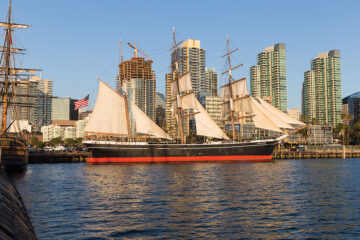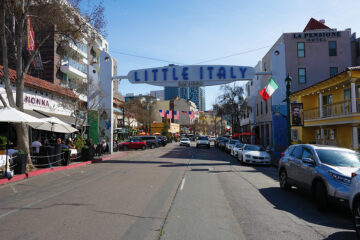A Water-Smart Garden

Conservazioni dell’acqua. Un Jarin A Faible Consommation d’Eau. Conservar el Aqua Inteligentemente. In whatever language it’s spoken, using less water has come of age. Gardeners and farmers in countries throughout the Mediterranean climate zone have practiced water conservation for thousands of years. Even in Southern California, water conservation was a given until the great water projects of the 1930s. Just walk through Balboa Park or any estate planted in the early 1900s to see the palette of plant material that can survive long periods during the summer with little water.
The current drought may be over, but anyone who has lived in California more than ten years knows that water levels in reservoirs are low more often than full. Water availability fluctuates and the cost of water only goes up.
If you have the “water will” to conserve, there are tools you can use in your garden. Simple ideas like irrigation management and mulching work for any size garden, while implementing greywater systems, rain harvesting, and garden design from the ground up provide more aggressive conservation.
Irrigation Management
Determine if your existing system was properly designed and installed, and that the water or “hydro” zones are properly separated. Lawns, shrub beds, slopes, and shady and sunny areas should all have individual valves with heads placed for a minimum of head-to-head coverage (meaning each head throws water to the next). Your system should be operated by a good electric irrigation controller.
Write down the numbers on your water meter weekly and track them for variances — this will help you know when you have a leak.
Check every sprinkler head in your garden monthly for clogged nozzles, broken risers, and bushes or grass blocking the spray pattern. Also check valves for leaks (if your valves are in below-grade boxes, examine inside the box for signs of flooding or wet soil) and flag them for your maintenance company to repair.
Program Your Irrigation Controller
Your goal should be deep watering without runoff. When watering slopes, shrub beds, and shady areas, set for fewer days per week than lawn areas. Program your controller to water between 3-6am when the water pressure is the greatest and the wind is calmest for better nozzle performance. In order to water each zone thoroughly with no run off, you may need to program two start times a couple of hours apart so the first cycle can soak in before applying more water.
In landscape areas 12 feet and wider, switch out conventional fan spray heads to rotating stream sprays, now available for smaller areas 12 feet up to 30 feet. For larger areas, install single jet stream rotors. These types of heads cover a larger area with less water, increasing the precipitation rate and reducing run off.
Install a rain shutoff device to prevent the system from coming on when more than a drizzle occurs. Several new smart controllers on the market can help you manage your water use with proper programming and continued monitoring.
If you follow these steps consistently, you will save 15 to 30 percent on your water use.
Mulching
Mulching fruit trees, planter beds, and slopes that are not 100 percent covered by foliage with a one to three-inch layer of mulch keeps roots cool and slows evaporation of soil moisture. Re-applying mulch once a year also helps build living soil, which cuts down on water and fertilizer needs. Mulching also reduces contaminate runoff during winter rains. The best mulches are shredded and have fibers that create a mat that stays in place better. Old wood chips and ornamental bark tend to float away with rain and end up in trash bags when raking up leaves. When figuring quantity of material, remember one cubic yard covers 324 square feet one-inch deep.
Another good mulch is gravel, crushed or smooth, depending on your style. It endures well and only needs replacement material every five to ten years.
Greywater Systems
Simple greywater systems that divert washing machine water into the garden have been a practice in rural areas for years. Check your city or county codes for proper handling — as of last year the regulations have eased on its use. Greywater is best used on fruit trees and perimeter screen plantings and should be applied to the landscape as soon as it comes from the source.
Today’s systems will collect greywater, and after it goes through a sand filter, the water is sent out via irrigation valves to individual zones as the controller dictates. If there is not enough water to finish a programmed cycle, the municipal water system kicks in. These systems can cost 30-50 percent more to install than a conventional irrigation system, but if you have a full house, it will quickly pay for itself.
Rain Harvesting
Rainwater harvesting is all about containment and how much room you can provide for storage. During the rainy season, for every inch of rainfall, the average 2,000-square-foot house can collect 1,250 gallons of water. In Southern California, a year’s rain would supply enough water for almost two weeks for the average home if you have room to store two or three 5,000-gallon tanks.
More and more I see people driving small hybrid cars to conserve gas and expense. We need this same kind of mindshift for our gardens and water use. With proper planning, designing a new garden or re-designing an existing garden that requires less water is by far the best way to a water-smart garden. WILLIAM C. SCHNETZ II







Comments